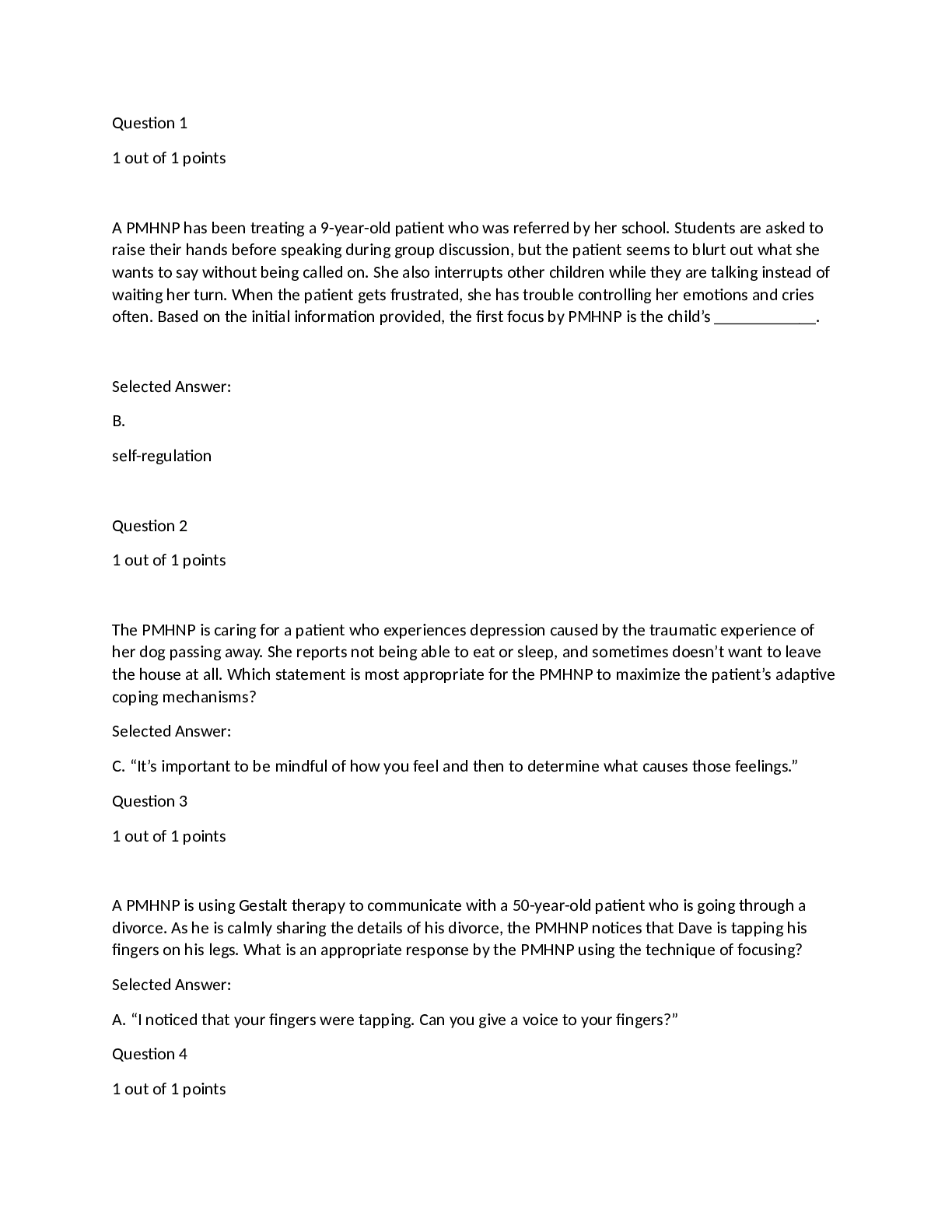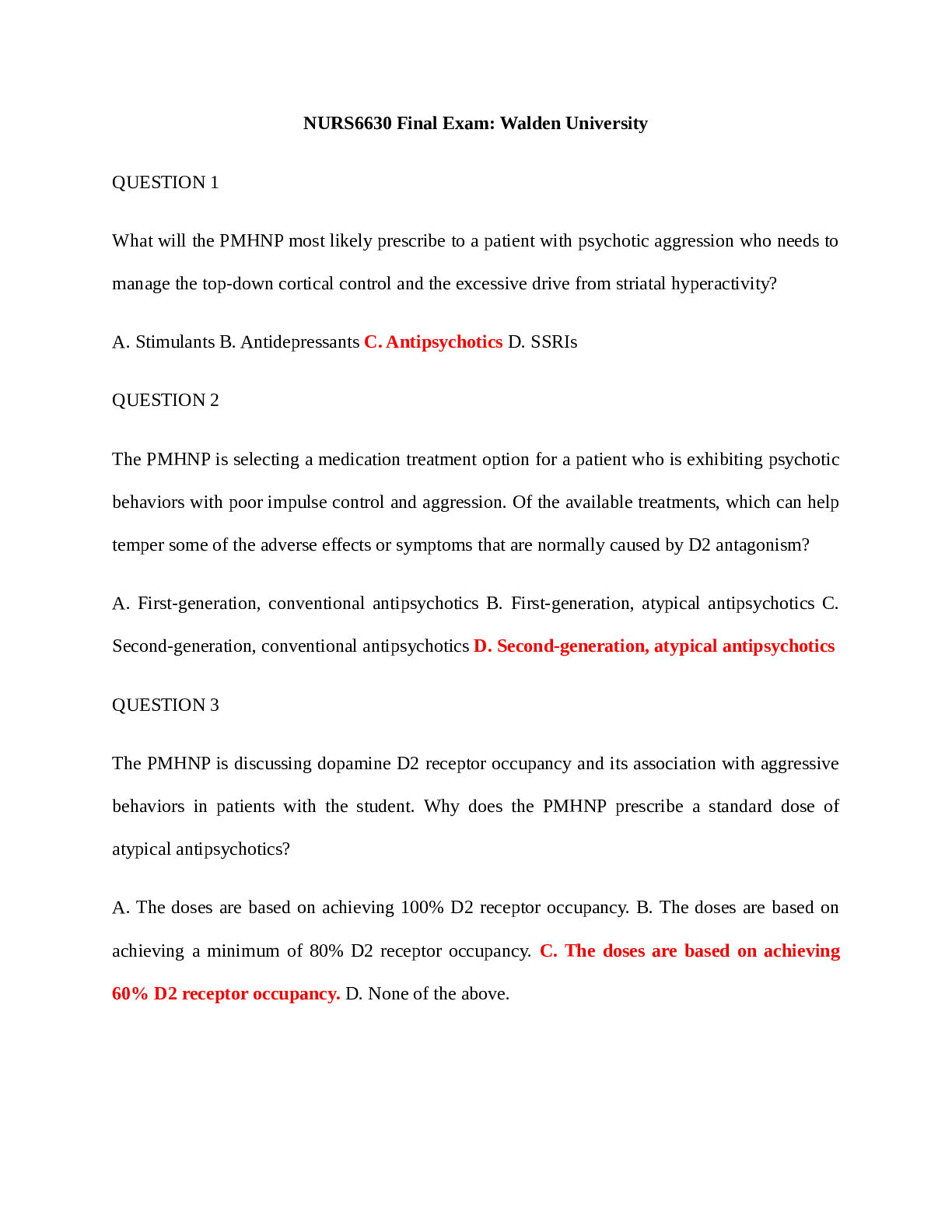Biology > EXAM > Physiology test bank biology 161 - Lecture Exam Review-latest and complete with explained answers (All)
Physiology test bank biology 161 - Lecture Exam Review-latest and complete with explained answers
Document Content and Description Below
HOMEOSTASIS CELL PHYSIOLOGY WATER pH – BIOCHEMISTRY – CELLULAR RESPIRATION MEMBRANES MEMBRANE POTENTIAL PPT 1 – HOMEOSTASIS 1. Define the term physiology, and explain the knowledge and intellect... ual characteristics of a good physiologist. 2. Explain why is it impossible to tease apart anatomy and physiology. 3. List the various levels of structural organization within the body, and give examples for various organ systems. 4. List the 11 organ systems. Which two systems comprise the circulatory system? 5. Explain why it is crucial to remember that the organ systems are all continuously working together. 6. Name the fluid that surrounds the body cells and separates them from the blood plasma. 7. Define homeostasis. 8. List and discuss the various survival needs of the body that are controlled by homeostasis. 9. Describe the general idea and two classes of homeostatic control mechanisms. 10. Explain a negative feedback system within the body, including its components. 11. Explain a positive feedback system within the body. 12. Discuss why is it so important to approach the study of physiology with the idea of homeostasis. Explain what can happen if homeostasis is disrupted. Physiology is the study of the body as it functions normally. Deviations of this norm will cause fluctuations in homeostasis. These can cause illness, death and are labeled disease. Pathophysiology studies these deviations. PPT 2 – CELL PHYSIOLOGY 13. Define the term cytology. Explain the various aspects of the cell theory. Name some unique cell types within the body. 14. Name and describe the three basic parts of any cell. Determine the importance of the cell membrane, and list the fluids that are separated by the cell membrane. 15. Describe what membrane junctions are, and explain the various ways that cells are held together. Give details regarding desmosomes, tight junctions and gap junctions. 16. List and describe organelles that produce substances for cells. Be able to discuss some of the products. 17. List and describe organelles that process cell products. 18. List and describe organelles that break down or neutralize substances within the cell. Differentiate between lysosomes and peroxisomes, and be able to discuss their individual enzymes as well as their functions. Note that lysosomes typically act on materials ingested through phagocytosis (cell eating), and peroxisomes typically act on materials ingested through pinocytosis (cell drinking). 19. Describe mitochondria and how they produce energy for the cell. 20. Describe vacuoles, and give an example of a tissue that heavily relies on its vacuoles. 21. Explain the structure and function of the cytoskeleton. 22. Differentiate between cilia and flagella, and discuss how each one provides movement for the cell. Name the cell structure that anchors cilia and flagella to the cell, and describe another function for that structure during periods of cell division. 23. Describe microvilli. 24. Describe the structure and function of the nucleus. What is the function of the nucleolus? Note that these structures are not organelles. PPT 3 – CHEMISTRY REVIEW 25. Describe the structure of an atom. Note the subatomic particles within and outside of the nucleus, as well as their charges. 26. Explain how an atom’s overall charge changes when it has more protons than electrons, or more electrons than protons. 27. Define ion. What is an electrolyte? 28. Differentiate among ionic bonds, covalent bonds and hydrogen bonds. Which two are bonds that occur within molecules? Which one is a bond that typically occurs between molecules? Which intramolecular bond involves the give-and-take of electrons versus the sharing of electrons? 29. Chemical bonds can be formed or broken. Which of these actions involves the storage of energy versus the release of energy? 30. Name the one and only energy molecule within the human body, which allows us to do all of our work. 31. Describe polar covalent bonds, which are especially important to the behavior of water molecules within the body. PPT 4 - WATER 32. List and describe properties of water that contribute to its essential role in human life. 33. Differentiate between the terms hydrophilic and hydrophobic. 34. Explain the difference between solvents and solutes. What causes a solution to become more concentrated? Discuss the differences among hypertonic, hypotonic and isotonic solutions, including their individual effects on human cells. Give examples of each type of solution. Define the terms hemolysis and crenation. 35. Define diffusion. What is the term for the diffusion of water? PPT 5 - pH 36. Know the range of the pH scale, in addition to its logarithmic properties. How many times more acidic is a substance with a pH of 5 than a substance with a pH of 7? 37. Which ions are given off by acids in solution, and what makes an acid a strong acid? 38. Which ions are given off by bases (alkaline substances) in solution, and what makes a base a strong base? 39. Define the normal range for blood pH, and note the definitions of acidosis versus alkalosis. Know the extreme pH levels of blood that can cause death. 40. What is the role of pH buffers within the body, and why are they so important? PPT 6 – BIOCHEMISTRY 41. Define the term macromolecule. Differentiate between polymers and monomers, and give examples of each for the four types of organic molecules within the body. 42. Discuss the functions of carbohydrates within cells, and give examples of various types of carbohydrates. 43. Discuss the functions of lipids within cells. List different types of lipids within the body, and explain the differences between saturated and unsaturated fatty acids. 44. Describe the various functions of proteins within the body. Explain the importance of amino acids. Generally discuss how proteins involve several levels of structure. How can extreme environmental conditions affect protein structure and function? Why should you expect to get diarrhea if you have a fever? 45. Discuss the functions of nucleic acids and nucleotides within cells. Identify the full names for the five nucleotides, and note the one nucleotide that is present within the ATP molecule. PPT 7 – CELLULAR RESPIRATION 46. Explain why the oxidation of food molecules within cells must be controlled. 47. Define cellular respiration and understand its importance to the body’s living state. 48. Describe the most important reactant for cellular respiration, as well as the most important product of the chemical reaction. 49. List the two reactants and three products of cellular respiration. 50. Discuss the details of glycolysis. Know its location in the cell, and whether or not it requires oxygen. 51. Discuss the details of Kreb’s cycle (citric acid cycle). Know its location in the cell, and whether or not it requires oxygen. 52. Discuss the details of oxidative phosphorylation. Know its location in the cell, and whether or not it requires oxygen. 53. Recognize that the number of ATP produced during cellular respiration may vary. PPT 8 - MEMBRANES 54. Explain the selective permeability of the cell membrane. Why is this important to the cell? 55. What specific type of lipid makes up the bilayer of the cell membrane? Explain the differences between the heads and the tails of these lipids, and discuss why these characteristics allow membranes to seal themselves when punctured. 56. What roles do cholesterols play in the cell membrane? 57. Compare and contrast exocytosis versus endocytosis. 58. Explain what is meant by the fluid mosaic model. What are the various characteristics of the structures of the cell membrane? 59. Describe the various functions of the membrane proteins. Differentiate between channel proteins and carrier proteins. 60. Compare and contrast passive transport versus active transport. Which one of the two requires ATP energy? PPT 9 – MEMBRANE POTENTIAL 61. Explain the differences in distributions of charges when membranes have no potential versus when they do have potential. 62. Describe the differences between the locations of positive and negative charges in a plasma membrane. 63. List the ions that are important to membrane potential, and for each one, determine whether the ion is more abundant in the intracellular fluid or extracellular fluid of a 64. List the two types of excitable tissues. Why might each tissue use an action potential? 65. Know the voltages for resting potential, threshold potential, full depolarization of the action potential, and full repolarization of the action potential into hyperpolarization. 66. Explain the propagation of an action potential along a plasma membrane. 67. Describe the mechanism of a voltage-gated channel, and actions of these for sodium ion and potassium ion control during action potentials. 68. Define and understand action potential, threshold stimulus, refractory period and the All or None Law. 69. Describe the directional movement of an action potential along a multipolar neuron. 70. Discuss the detailed events of the nerve impulse. 71. Explain the role of the sodium-potassium pump to the cell. 72. Describe the transmission of an action potential along a myelinated axon, and explain why this may be beneficial. [Show More]
Last updated: 1 year ago
Preview 1 out of 13 pages
Instant download
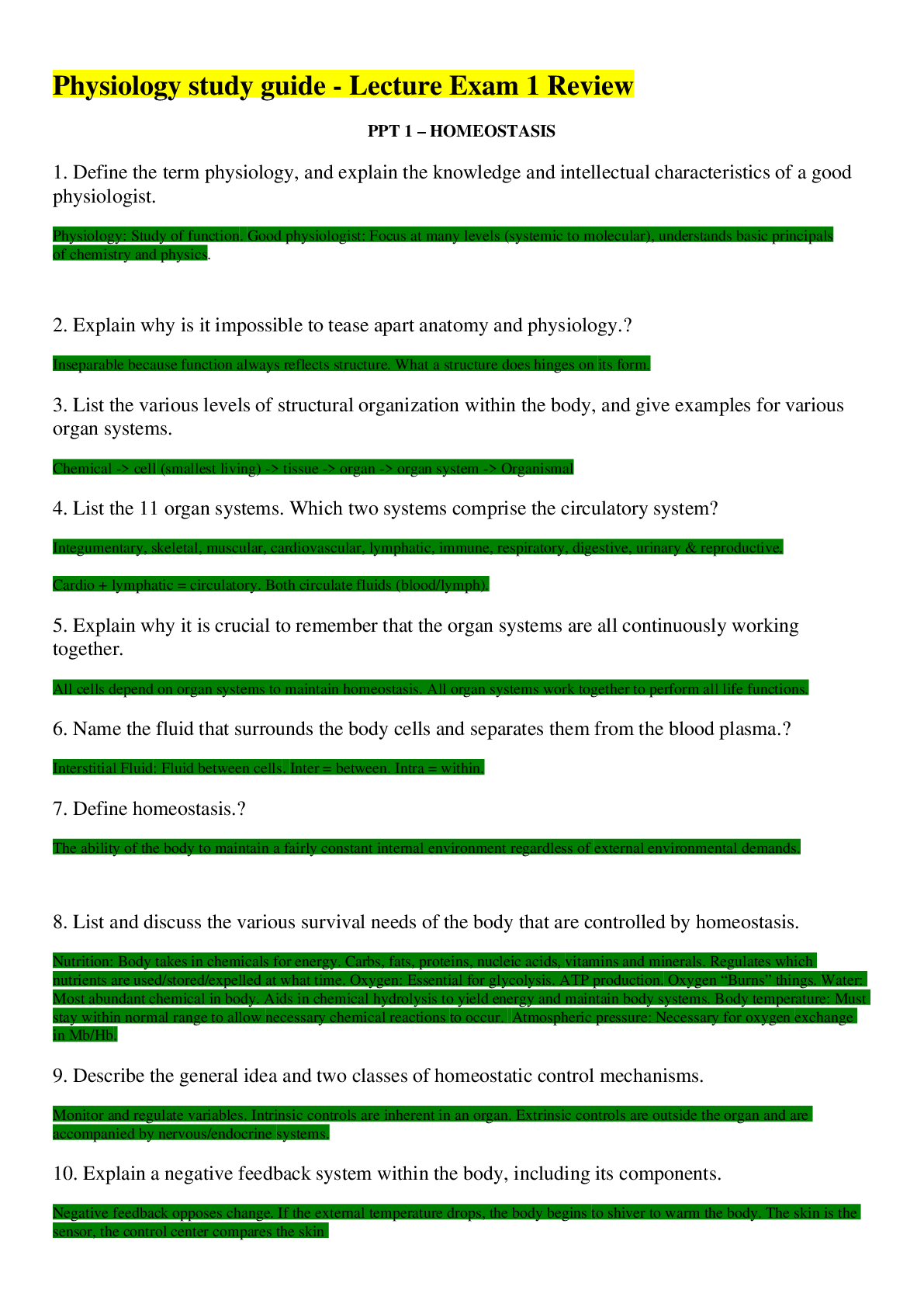
Buy this document to get the full access instantly
Instant Download Access after purchase
Add to cartInstant download
Reviews( 0 )
Document information
Connected school, study & course
About the document
Uploaded On
Jun 19, 2020
Number of pages
13
Written in
Additional information
This document has been written for:
Uploaded
Jun 19, 2020
Downloads
0
Views
88

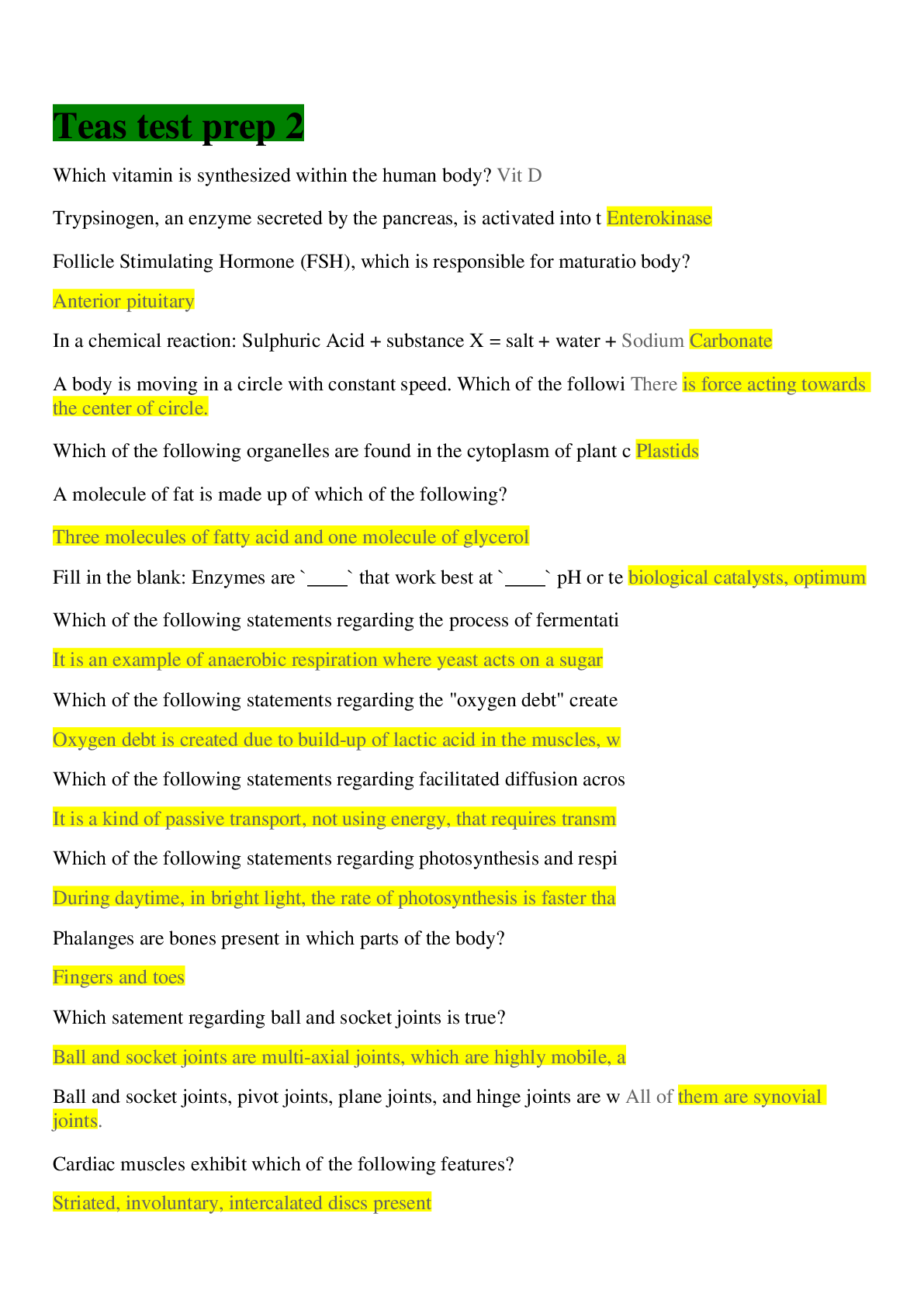
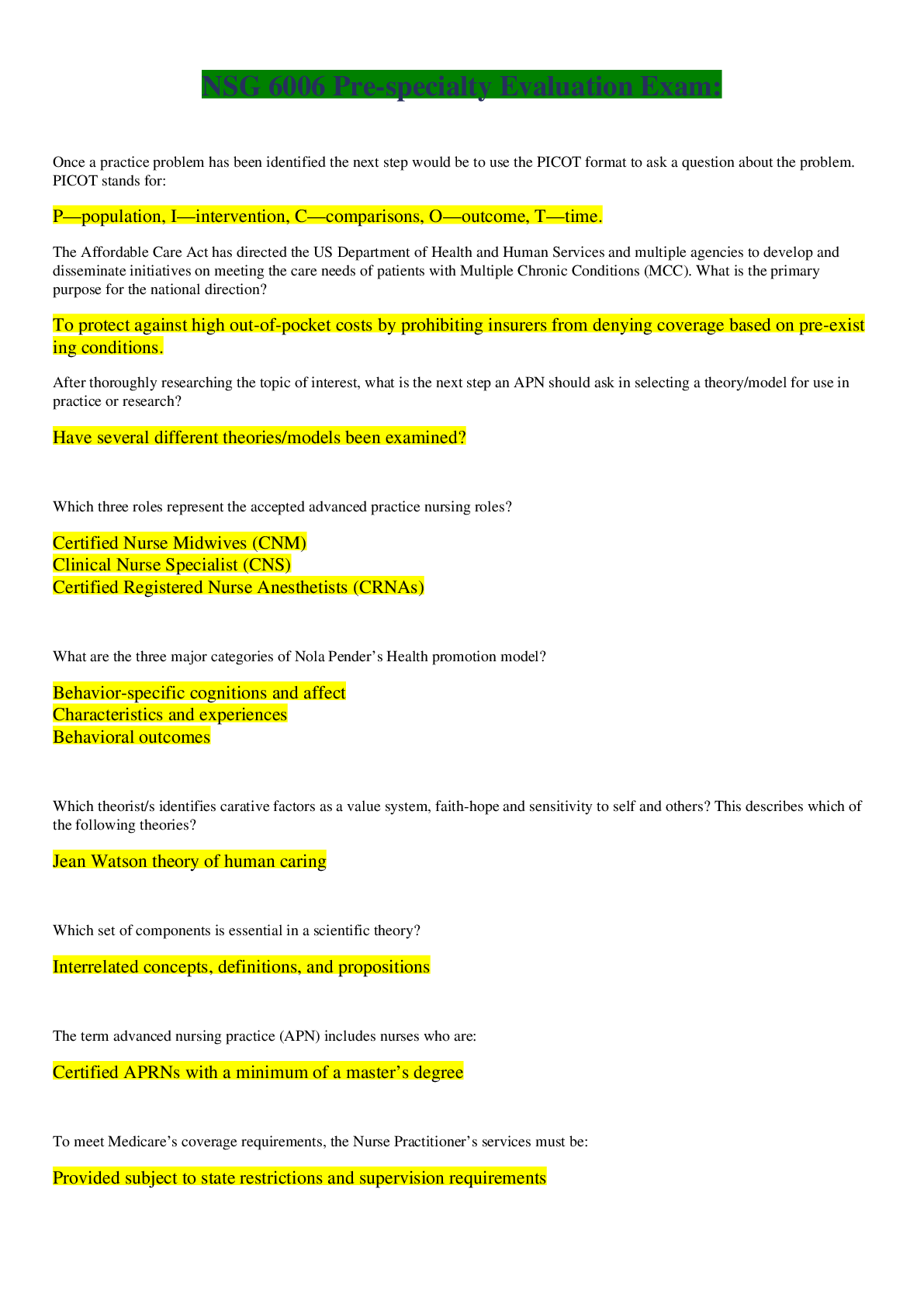
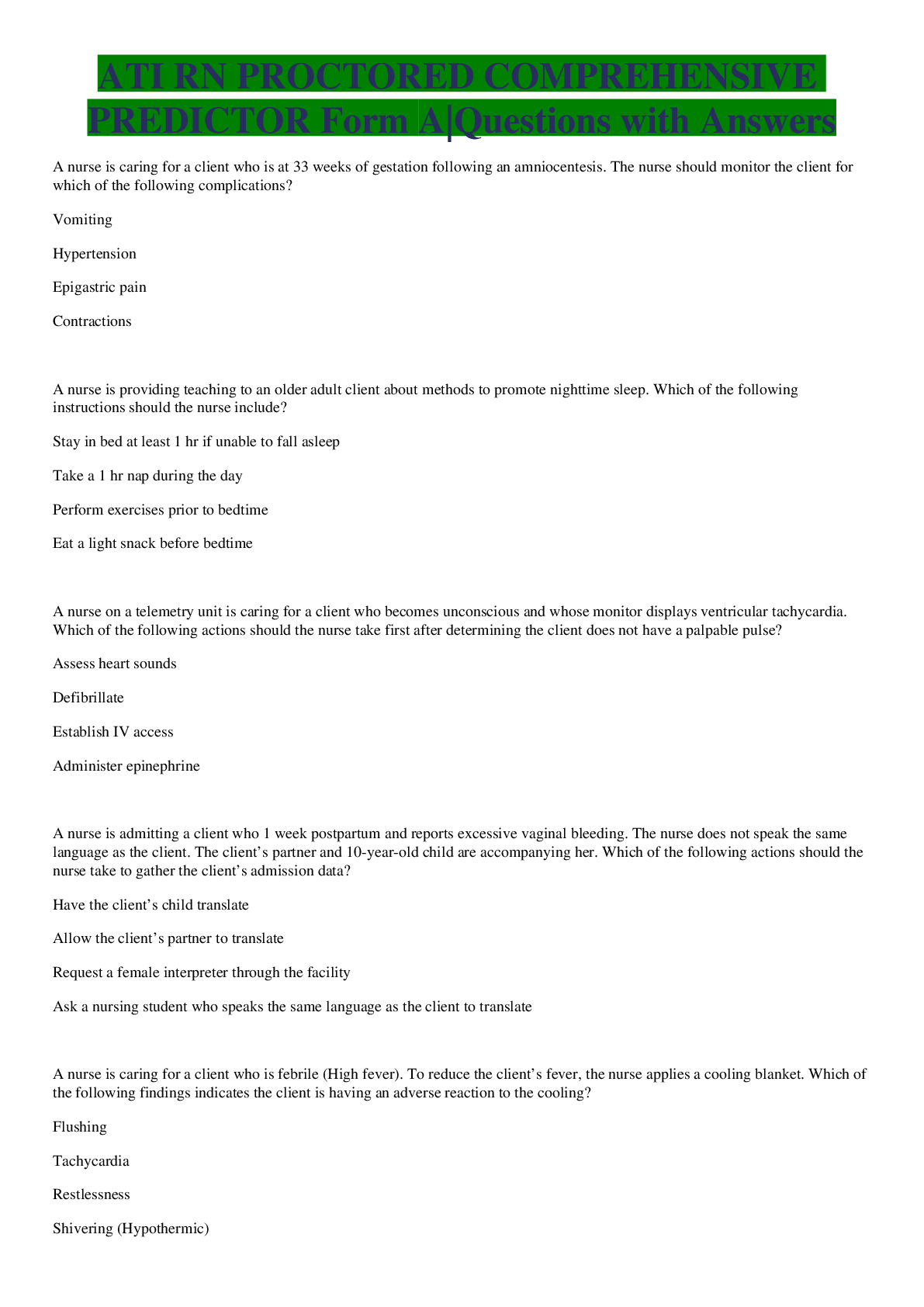
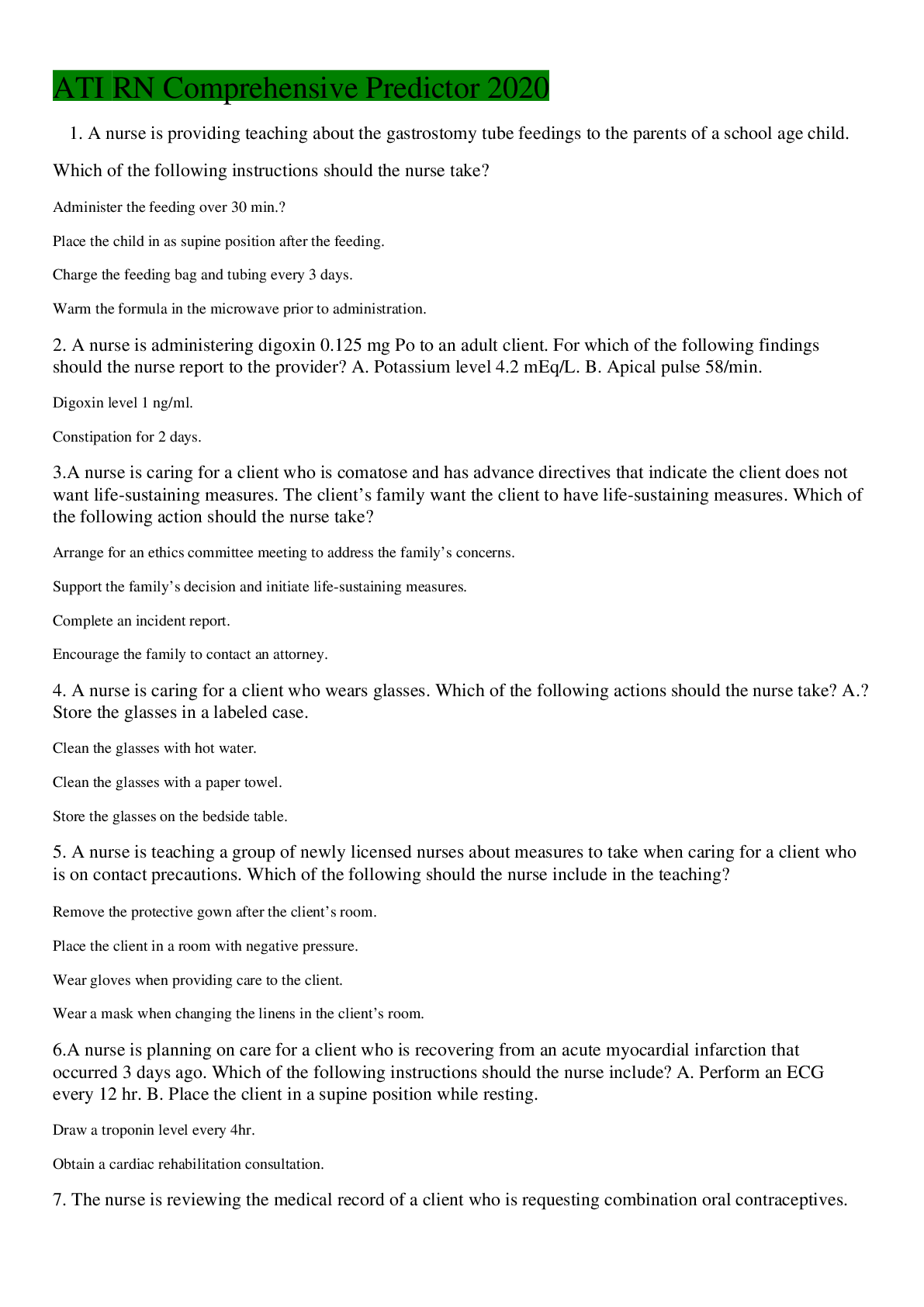



.png)
